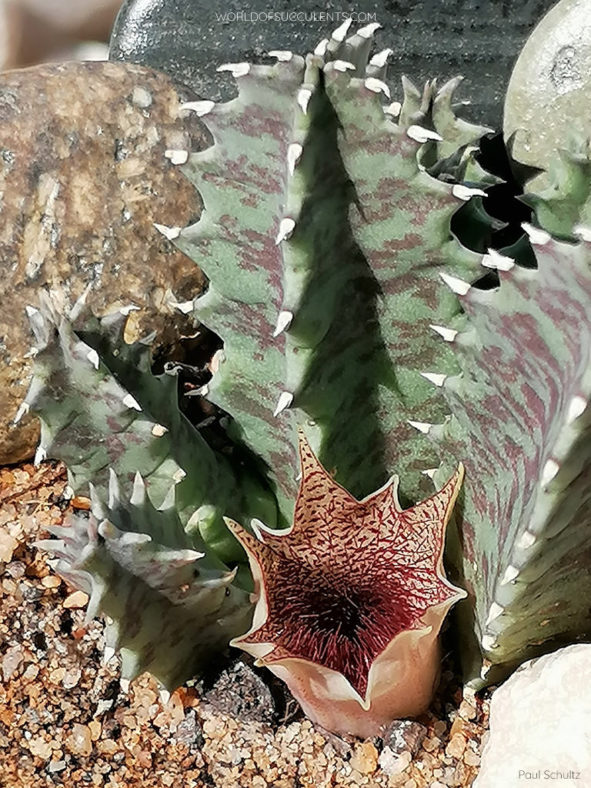Scientific Name
Huernia barbata (Masson) Haw.
Synonym(s)
Huernia barbata subsp. barbata, Stapelia barbata
Scientific Classification
Family: Apocynaceae
Subfamily: Asclepiadoideae
Tribe: Stapeliae
Genus: Huernia
Etymology
The specific epithet "barbata (pronounced bar-BAY-tuh)" is a Latin adjective meaning "bearded" and refers to the long hairs found on the flowers.
Origin
Huernia barbata is native to South Africa. It grows on stony slopes under bushes and in crevices in rocks from Pofadder in the Northern Cape to Vanrhynsdorp, Karoopoort, and Montagu in the Western Cape and Port Elizabeth in the Eastern Cape.
Description
Huernia barbata is a small succulent that forms dense clumps of short, often very stout stems with spreading deltoid tubercles joined into 4 to 5 angles. It can grow up to 2.4 inches (6 cm) tall and 12 inches (30 cm) in diameter. The stems are grey-green, sometimes mottled with purple-red. They can measure up to 4 inches (10 cm) long and 0.8 inches (2 cm) thick.
The flowers are bell-shaped with five nearly triangular lobes and appear solitary or in a cluster of 2 to 5 near the base of stems on a short peduncle, opening successively from the end of summer through fall. They can reach up to 2.6 inches (6.5 cm) long and 2.4 inches (6 cm) in diameter. There are five small secondary lobe tips halfway between the big ones. Outside, the flowers are smooth, cream to greenish, with 3 to 5 raised longitudinal veins and sometimes speckled with maroon. Inside, they are cream to pale yellow with maroon spots and long, often club-shaped hairs in the mouth of the tube and onto petals. The seed pods are paired follicles that resemble paired horns and appear up to a year after flowering.

How to Grow and Care for Huernia barbata
Light: H. barbata prefers bright light or partial shade during hot summer days. Too much sun causes stems to develop protective pigmentation or get sunburned, while too little light leads to weak, thin stems and decreased flower production. Indoors, place the plant near the brightest window in your home.
Soil: The right soil is crucial to successfully growing H. barbata. Use a commercial potting soil mix for succulents, or prepare your own with 50 to 70 % mineral grit, such as coarse sand, pumice, or perlite.
Temperature: This plant thrives in warm outdoor environments with low to moderate humidity. It does not like winter cold and should remain fairly dry and warm during its dormancy. H. barbata can withstand temperatures as low as 40 °F (4.4 °C). USDA Plant Hardiness Zones 11a to 11b are 40 to 50 °F (4.4 to 10 °C).
Watering: H. barbata has typical watering needs for a succulent. During the growing season, water your plant thoroughly and allow the soil to dry between waterings. In winter, the plant goes dormant and needs almost no water, about once a month.
Fertilizing: To keep your plant healthy and thriving, fertilizing during the growing season is a good idea. Feed with water-soluble fertilizer diluted to half the recommended strength.
Repotting: H. barbata will benefit from fresh potting soil every 2 or 3 years. Repot your plant in spring, just before the growing season. Pick a container with drainage holes.
Propagation: The best way to propagate this succulent is by stem cuttings. Take cuttings during the growing season to ensure good rooting. H. barbata is also easy to grow from seeds. Sow the seeds in spring.
Learn more at How to Grow and Care for Huernia.
Toxicity of Huernia barbata
H. barbata has no toxic effects reported. It is safe around pets and humans.
Links
- Back to genus Huernia
- Succupedia: Browse succulents by Scientific Name, Common Name, Genus, Family, USDA Hardiness Zone, Origin, or cacti by Genus
Photo Gallery
Click on a photo to see a larger version.


